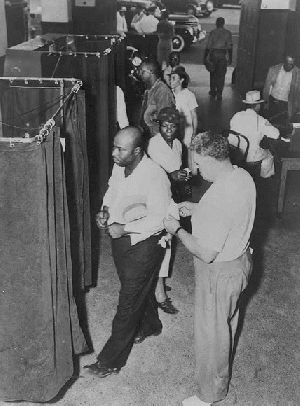
Still Using The Same Old Voting System
(Image by (Not Known) Wikipedia, Author: Author Not Given) Details Source DMCA
Instant Runoff Balanced Voting (IRBV) is a form of BV that shares all the advantages of both balanced voting and of IRV. It gives full expression to a voter's opposition to as well as support for as many candidates as the voter wants. On the downside it remains, like IRV, one of the most complicated of voting systems. But from just the voters' perspective, the mechanics of voting with IRBV may actually seem a bit easier to the individual voter than IRV because IRBV is less likely to force a voter to make arbitrary decisions and it makes it easier for a voter to accurately express opinions about the candidates.
Both IRV and IRBV model themselves on the idea of conducting a series of runoff elections, but not by asking voters to return again and again to the polls. Instead, each runoff in the series of elections is conducted by counting the one set of ballots to eliminate just one of the candidates. The difference between the two systems is that with IRV each count is conducted using our traditional First-choice form of voting (commonly called plurality voting). With IRBV, each of the runoff counts is conducted using the balanced voting system we described in What Might be the Best Voting System ad BV-1.
As with IRV, the voter is asked to prepare an ordered list of candidates. With IRV, this list is expected to reflect, in decreasing order, the level to which the voter supports the candidates. But in the case of IRBV, the order instead should be based on how strongly the voter feels, one way or another, about that candidate. For each candidate on the voter's list, the voter indicates whether that ranked vote is for or against the candidate.
The counting is much as it is with IRV except that each iteration counting is done in the manner of balanced voting. In the first instance, the count of votes depends only on the first entry in each voter's list (the net vote being determined as number of first-listed votes for each candidate less the number of votes against that candidate). The candidate with the smallest net vote is removed from consideration in the next iteration of the count. In the second and subsequent counts, the candidates who have been eliminated from any earlier iteration of the count are stricken from each voter's ballot and the remaining candidates are promoted accordingly. Just as with IRV, in a contest between N candidates, N-1 counts are conducted with one candidate being eliminated with each count.
IRBV is an instance of BV because any vote for or against a given candidate can be canceled by another vote from someone with the opposite opinion. In any of the counts, there is an opportunity for these votes to cancel, resulting in a net of zero votes for even the major-party candidates in a badly polarized political environment (such as now seems common in the United States). It seems likely that IRBV will give minor-party candidates a better chance to win than will IRV.
It is hard to think of a good argument why IRBV might be preferred over the Balanced Approval Voting (BAV) system introduced in in What Might be the Best Voting System?, but no doubt an argument can be made. Perhaps someone can offer an argument for this as a comment.





